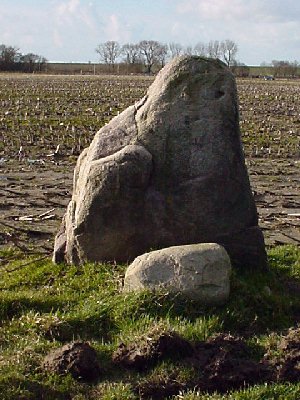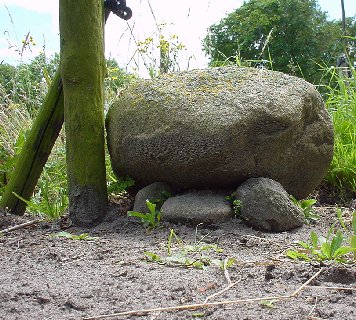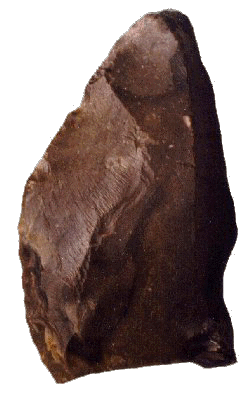the History of Wieringen
Prehistoric times
 The stone at Westerklief |
Wieringen got its present shape during the penultimate iceage (ca. 150.000 to 100.000 B.C), the Saalien. The rolling hills have been formed in this period. They have been pushed up by glaciers. Remnants of that period in time can be found in many Wieringer gardens in the form of large boulders. They have been carried here by the glaciers. Few people realise that these rocks originate in Sweden and Finland and may be as old as 3 billion years. The best known boulder (though it is not the largest) can be found in a meadow at Westerklief, a hamlet southwest of Hippolytushoef, and is approximately 2 metres high (with the part that's in the ground added. The largest boulder on Wieringen is at a farmyard at the Hopperweg (just outside Hippolytushoef). The farm is aptly named "De Zwerfkei" (the boulder). The maximum length of this stone is 222 cm, the weight is estimated to be 4500 kilos. The rock was found in the southern part of Wieringen, the Hippolytushoever koog.
|
 Before the introduction of barbed wire boulders were used as dolleve, boundarystones. Underneath the large topstone the owner of the land put a number of smaller stones in a specific pattern only known to him. This made it possible for him to check whether the stone had not been secretly moved. To the left you can see one of the few remaining boulderstones. It is at the Heid (Akkerweg, Oosterland). |
About 75000 years B.C. the last iceage, the Weichselien starts. The low countries are not covered underneath the ice in this period, but the climate changes to that of a polar tundra. In this period, lasting until about 10000 years B.C., modern man first sets foot to this region. When the first groups of modern people reached Wieringen and surroundings is unknown, but it is certain that it is a very long time ago.  The discovery of a primitive stone tool near Hippolytushoef suggests that the earliest settlement of Wieringen might have been 70000 years ago. If this finding is authentic it may even mean that Homo Sapiens Neandertalensis (Neandertal-man) could have wandered in this area. The discovery of a primitive stone tool near Hippolytushoef suggests that the earliest settlement of Wieringen might have been 70000 years ago. If this finding is authentic it may even mean that Homo Sapiens Neandertalensis (Neandertal-man) could have wandered in this area.
It is not surprising that only a very limited number of finding remembers of these first inhabitants, but they certainly were here. People from these early cultures left not many material objects behind and on top of that the majority of the settlementareas from the later stoneage, bronze age and iron age (mostly just behind the dunes that used to be west of the present coastline) have been flooded by the sea for some time. Around 2000 B.C. the living circumstances in North-Holland are that bad that it is almost impossible to live here. Only higher areas like Wieringen and Texel are still inhabitable. (see map of Noord-Holland 2500 B.C.) This means the chance of finding prehistoric artefacts on Wieringen is significantly higher than in other parts of northern North-Holland. However, this doesn't mean stone tools are around in high numbers. Finding them still remains a matter of luck. The most spectacular finding in this respect was that of a prehistoric camp near Slootdorp in the Wieringermeer some years ago. A stoneage hunting camp has been dug up there. From the findings it became clear that a group of people lived here who belonged to the culture of the megalithbuilders from the eastern part of the Netherlands.
The museum for regional geology and archaeology "Het huis van de Aarde" in Den Oever, has a fine exhibit on the development of the local landscape. At the museum's website prehistoric findings are described in more detail.
start / Dutch | history | legends | old photos | villages | anthem | links | search
| 

